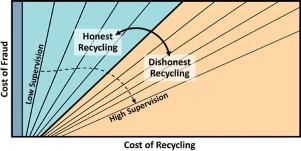Resources, Conservation and Recycling ( IF 13.2 ) Pub Date : 2021-05-03 , DOI: 10.1016/j.resconrec.2021.105613 Daniel Salmon , Callie W. Babbitt , Gregory A. Babbitt , Christopher E. Wilmer

|
Despite the adoption of electronic waste recycler certification schemes in the United States, there remain notable instances in which recyclers might engage in dishonest practices. To better understand mechanisms that may encourage honest electronics end-of-life management, we develop a framework to analyze the decision calculus of electronic waste recyclers facing a decision between an honest choice that might be more expensive or a dishonest choice that saves money but has some probability of being caught. Building an analytical decision tree model under which a recycler maximizes expected returns, we explore the influence of supervision on the choices a recycler faces and provide an analytical solution that describes the boundaries that separate those choices. Using our framework, we systematically catalog which interventions may help and which may not. The model suggests that direct unqualified subsidies to recyclers may not be particularly effective, although properly targeted subsidies have promise. We also find that there are substitution effects between increasing the cost of fraud and decreasing the costs of proper electronic waste recycling. That is, increasing the cost of fraud can serve as a policy instrument to produce effects similar to decreasing a recycler’s costs from engaging in honest behavior. We also discuss the role of digital fraud prevention technologies such as blockchain as another mechanism to help achieve sustainability outcomes in e-waste management while lowering the costs of third-party supervision.
中文翻译:

在电子废物管理中对欺诈进行建模的框架
尽管美国采用了电子废物回收商认证计划,但仍有明显的情况,回收商可能会采取不诚实的做法。为了更好地理解可能鼓励诚实的电子报废管理的机制,我们开发了一个框架来分析电子废物回收商的决策演算,这些决策面临着可能是更昂贵的诚实选择还是省钱但有成本的不诚实选择之间的决策。被抓住的几率。建立一个分析决策树模型,在此模型下,回收商可以获得最大的预期收益,我们探索监管对回收商面临的选择的影响,并提供描述分离这些选择的边界的分析解决方案。使用我们的框架,我们系统地列出了哪些干预措施可能会有所帮助,哪些可能没有帮助。该模型表明,尽管有针对性的补贴有望实现,但直接向回收商提供不合格的补贴可能并不是特别有效。我们还发现,在增加欺诈成本和降低适当的电子废物回收成本之间存在替代效应。也就是说,增加欺诈成本可以作为一种政策手段,产生与减少诚实行为引起的回收商成本类似的效果。我们还将讨论诸如区块链之类的数字欺诈预防技术的作用,这是另一种机制,可帮助实现电子废物管理的可持续性成果,同时降低第三方监管的成本。该模型表明,尽管有针对性的补贴有望实现,但直接向回收商提供不合格的补贴可能并不是特别有效。我们还发现,在增加欺诈成本和降低适当的电子废物回收成本之间存在替代效应。也就是说,增加欺诈成本可以作为一种政策手段,产生与减少诚实行为引起的回收商成本类似的效果。我们还将讨论诸如区块链之类的数字欺诈预防技术的作用,这是另一种机制,可帮助实现电子废物管理的可持续性成果,同时降低第三方监管的成本。该模型表明,尽管有针对性的补贴有望实现,但直接向回收商提供不合格的补贴可能并不是特别有效。我们还发现,在增加欺诈成本和降低适当的电子废物回收成本之间存在替代效应。也就是说,增加欺诈成本可以作为一种政策手段,产生与减少诚实行为引起的回收商成本类似的效果。我们还将讨论诸如区块链之类的数字欺诈预防技术的作用,这是另一种机制,可帮助实现电子废物管理的可持续性成果,同时降低第三方监管的成本。我们还发现,在增加欺诈成本和降低适当的电子废物回收成本之间存在替代效应。也就是说,增加欺诈成本可以作为一种政策手段,产生与减少诚实行为引起的回收商成本类似的效果。我们还将讨论诸如区块链之类的数字欺诈预防技术的作用,这是另一种机制,可帮助实现电子废物管理的可持续性成果,同时降低第三方监管的成本。我们还发现,在增加欺诈成本和降低适当的电子废物回收成本之间存在替代效应。也就是说,增加欺诈成本可以作为一种政策手段,产生与减少诚实行为引起的回收商成本类似的效果。我们还将讨论诸如区块链之类的数字欺诈预防技术的作用,这是另一种机制,可帮助实现电子废物管理的可持续性成果,同时降低第三方监管的成本。


























 京公网安备 11010802027423号
京公网安备 11010802027423号